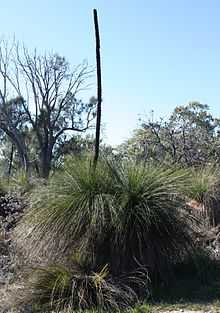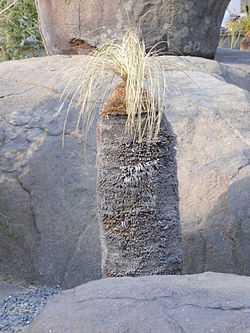Xanthorrhoea preissii
| Xanthorrhoea preissii | |
|---|---|
 | |
| Scientific classification | |
| Kingdom: | Plantae |
| Clade: | Angiosperms |
| Clade: | Monocots |
| Order: | Asparagales |
| Family: | Xanthorrhoeaceae |
| Subfamily: | Xanthorrhoeoideae |
| Genus: | Xanthorrhoea |
| Species: | X. preissii |
| Binomial name | |
| Xanthorrhoea preissii Endl. | |
| Synonyms | |
| |
Xanthorrhoea preissii (synonyms X. pecoris, X. reflexa[1]) , with the common name Balga, is a widespread species of perennial monocot in Southwest Australia. This plant, and other members of the genus Xanthorrhoea, are also known as grasstrees.[2] The form of the plant resembles a tree, with very long and bunched, grass-like, leaves that emerge from a central base.

It is found throughout coastal plains, near watercourses, and inland forest regions, in a range extending from Geraldton to Albany and in the Avon Wheatbelt. It occurs on a wide variety of soil types and is sometimes associated with laterite and granite.[2]
The species had a high economic importance to the Noongar people, who named it Balga, using the gum it contains, the spike for fish spears, and the Bardi grub as a source of food. Anecdotal information on the species refers to an association with fire in the culture of those people.[3] It was first described by Stephan Endlicher in the 1846 volume of Plantae Preissianae.[4] The appearance of the plant was seen as resembling a native inhabitant, holding a spear, by the early settlers of the region[citation needed]; in Western Australia it is commonly referred to as a blackboy.[5]
The species is named as one of the dominant taxa in Corymbia calophylla – Xanthorrhoea preissii woodlands and shrublands of the Swan Coastal Plain, a critically endangered ecological community, once widespread and now restricted to a narrow range. Its occurrence is a characteristic of two other Marri (Corymbia calophylla) communities, but the Marri/Xanthorrhoea community is distinguished by the drier soils of the communities range along the eastern edge of the Swan Coastal Plain.[6]
References

- ↑ World Checklist of Selected Plant Families. The Board of Trustees of the Royal Botanic Gardens, Kew. Retrieved 2011-06-27.
- ↑ 2.0 2.1 "Xanthorrhoea preissii". FloraBase. Department of Environment and Conservation, Government of Western Australia.
- ↑ 3.0 3.1 Ward, D J; Lamont, B B. "Probability of grasstrees (Xanthorrhoea preissii) flowering after fire". Journal of the Royal Society of Western Australia (83): 13–16.
- ↑ Lehm., Plantae Preissianae 2:39 (1846)
- ↑ Gardner, C.A. (1981). Wildflowers of Western Australia. Perth: St George Books. p. 10. ISBN 0-909699-01-1.
- ↑ "Corymbia calophylla – Xanthorrhoea preissii woodlands and shrublands of the Swan Coastal Plain.". Threatened species & ecological communities. Department of the Environment, Water, Heritage and the Arts. 19 Feb 2007. Retrieved 2009-05-31.
External links
| Wikimedia Commons has media related to Xanthorrhoea preissii. |